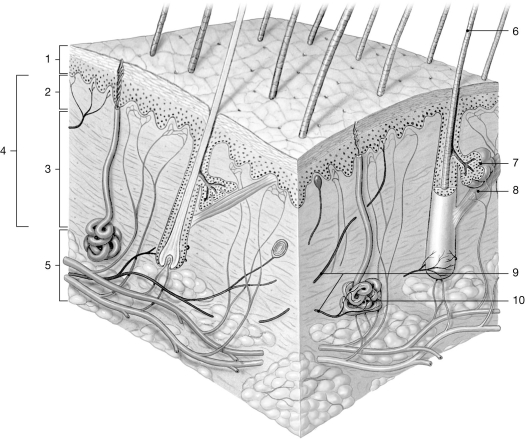A) carotene and xanthophyll.
B) carotene and melanin.
C) melanin and chlorophyll.
D) xanthophyll and melanin.
E) none of the above
Correct Answer

verified
Correct Answer
verified
Multiple Choice
The protein that permits stretching and recoiling of the skin is
A) collagen.
B) melanin.
C) keratin.
D) elastin.
E) carotene.
Correct Answer

verified
Correct Answer
verified
Multiple Choice
 Figure 5-1 The Components of the Integumentary System
Use Figure 5-1 to answer the following question(s) :
-While walking barefoot on the beach, Joe stepped on a thorn that penetrated through the sole of his foot to the dermis. How many layers of epidermis did the thorn penetrate?
Figure 5-1 The Components of the Integumentary System
Use Figure 5-1 to answer the following question(s) :
-While walking barefoot on the beach, Joe stepped on a thorn that penetrated through the sole of his foot to the dermis. How many layers of epidermis did the thorn penetrate?
A) 1
B) 2
C) 3
D) 4
E) 5
Correct Answer

verified
Correct Answer
verified
Multiple Choice
Each of the following statements concerning sebaceous glands and sebum is True , except one. Identify the exception.
A) Most sebaceous glands are coiled tubular glands.
B) Most sebaceous glands open into hair follicles.
C) Sebum functions to lubricate the hair and skin.
D) Sebum can function as an antibiotic.
E) Acne involves inflammation of sebaceous glands.
Correct Answer

verified
Correct Answer
verified
Multiple Choice
All of the following are True of the hypodermis (subcutaneous layer) , except it
A) contains many blood vessels.
B) permits independent movement of deeper structures.
C) contains large amounts of adipose tissue.
D) is attached to the dermis by a basement membrane.
E) stores energy reserves.
Correct Answer

verified
Correct Answer
verified
Multiple Choice
The nail body covers the
A) nail root.
B) nail bed.
C) lunula.
D) free edge.
E) hyponychium.
Correct Answer

verified
Correct Answer
verified
Multiple Choice
Each of the following is a function of the integumentary system, except
A) protection of underlying tissue.
B) excretion of salts and wastes.
C) maintenance of body temperature.
D) synthesis of vitamin C.
E) provision of sensation.
Correct Answer

verified
Correct Answer
verified
Multiple Choice
The layer of the skin that contains bundles of collagen and elastic fibers responsible for the strength of the skin is the ________ layer.
A) papillary
B) reticular
C) epidermal
D) subcutaneous
E) hypodermal
Correct Answer

verified
Correct Answer
verified
Multiple Choice
Skin can regenerate effectively even after considerable damage has occurred because
A) the epidermis of the skin has a rich supply of small blood vessels.
B) stem cells persist in both epithelial and connective-tissue components of the skin even after injury.
C) fibroblasts in the dermis can give rise to new germinal cells in the epidermis.
D) contraction in the area of the injury brings cells of adjacent strata together.
E) cells of the stratum basale cannot migrate to other positions in the skin.
Correct Answer

verified
Correct Answer
verified
Multiple Choice
Accessory structures of the skin include all of the following, except
A) hair follicles.
B) sebaceous glands.
C) sweat glands.
D) epidermis.
E) lamellated corpuscles
Correct Answer

verified
Correct Answer
verified
Multiple Choice
Dandruff is a disorder that results in dry skin flakes forming in the scalp. A common cause of dandruff could be
A) inflammation around sebaceous glands.
B) lack of lamellated corpuscles.
C) overactive sebaceous glands.
D) inactive apocrine sweat glands.
E) inactive merocrine sweat glands.
Correct Answer

verified
Correct Answer
verified
Multiple Choice
Characteristics of the epidermis include
A) multilayered.
B) flexible.
C) self-repairing.
D) serving as UV radiation protection.
E) all of the above
Correct Answer

verified
Correct Answer
verified
Short Answer
The substance called sebum is commonly known as ________.
Correct Answer

verified
Correct Answer
verified
Multiple Choice
Wrinkles in elderly individuals are the result of
A) increased production of epidermis.
B) loss of elastic filaments in the reticular layer of the dermis.
C) increased keratinization of the epidermis.
D) the loss of glands and hair follicles from the skin.
E) decreased thickness of the dermis.
Correct Answer

verified
Correct Answer
verified
Multiple Choice
 Figure 5-1 The Components of the Integumentary System
Use Figure 5-1 to answer the following question(s) :
-From what structure does merocrine secretion occur?
Figure 5-1 The Components of the Integumentary System
Use Figure 5-1 to answer the following question(s) :
-From what structure does merocrine secretion occur?
A) 6
B) 7
C) 8
D) 9
E) 10
Correct Answer

verified
Correct Answer
verified
Multiple Choice
The layer of hard keratin that coats the hair is termed the
A) medulla.
B) cuticle.
C) hair bulb.
D) root.
E) shaft.
Correct Answer

verified
Correct Answer
verified
Short Answer
________ is a pigment found in vegetables that can make the skin appear orange or yellow.
Correct Answer

verified
Correct Answer
verified
Multiple Choice
The following are stages in the regeneration of skin following an injury. 1) blood clot/scab formation 2) cellular migration 3) epidermis covers granulation tissue 4) epidermis covers scar tissue The correct order for these events is
A) 1, 2, 3, 4.
B) 4, 3, 2, 1.
C) 4, 3, 1, 2.
D) 3, 4, 1, 2.
E) 2, 4, 1, 3.
Correct Answer

verified
Correct Answer
verified
Short Answer
________ are coarse pigmented hairs.
Correct Answer

verified
Correct Answer
verified
Multiple Choice
Thin skin contains ________ layer(s) of keratinocytes, and thick skin contains ________ layers.
A) 1; 2
B) 2; 3
C) 3; 4
D) 4; 5
E) 5; 6
Correct Answer

verified
Correct Answer
verified
Showing 41 - 60 of 83
Related Exams